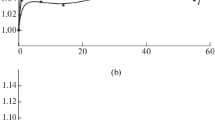Abstract
Copolyesters of aliphatic monomers with a defined amount of terephthalic acid recently have been shown to be biodegradable. This group of plastic materials exhibits very interesting material properties with regard to their technical application potential. A tensile strength of 25 N/mm2 combined with elongations at break up to 1500% was achieved for BTA materials. Melting points varied from 80 to 140‡C. Biodegradation rate under compositing conditions were determined, showing typical erosion rates of films, in the range of 5 to 10 Μm/week. The material properties and the degradation rate as well can be adjusted by the copolymer composition. Stretching of the polymer in the cold state leads to 10-fold higher mechanical strength of the material. The polyester chain can be extended to high molar masses, resulting in melt viscosities suitable, e.g., for melt below extrusion.
Similar content being viewed by others
References
J. Westerhausen, H. Utz, and D. Brune (1990) BMFT Report No. 01-ZV-8904.
U. Witt, R.-J. Müller, and W.-D. Deckwer (1995) German patent application (1) 95 08 737.2.
U. Witt, R.-J. Müller, and W.-D. Deckwer (1995)J. Environ. Poly. Degrad. 3(4), 215–223.
U. Witt, R.-J. Müller, and W.-D. Deckwer (1996)Macromol. Chem. Phys. 197, 1525–1535.
U. Witt, R.-J. Müller, and W.-D. Deckwer (1996)J. Environ. Poly. Degrad. 4(1), 9–20.
P. Raschle (1992) IBRG/PLA 92/06, International Biodeterioration Research Group.
D. Braun, H. Cherdron, and W. Kern (1979)Praktikum der makromolekularen organischen Chemie, 3. Aufl., Hüthig Verlag, Heidelberg.
J. M. G. Cowie (1976)Chemie und Physik der Polymeren, Verlag Chemie, Weinheim, New York.
J. Nentwig (1991)Lexikon Folientechnik, VCH, Weinheim.
E. Takiyama and T. Fujimaki (1994) in Y. Doi and K. Fukada (Eds.),Biodegradable Plastics and Polymers, Elsevier Science B.V., pp. 150–174.
Y. Yokota, R. Ishioka, Y. Moteki, and N. Watanabe (1994)Biodegradable Plastics and Polymers, Elsevier, New York, pp. 577–583.
U. Witt, R.-J. Müller, and W.-D. Deckwer (1995) German patent application (1) 95 32 771.3.
Y. Tokiwa, T. Suzuki, and K. Takeda (1988)Agr. Biol. Chem. 42(8), 1937–1943.
J. Emberger (1993)Kompostierung und VergÄrung, Vogel Buchverlag.
Author information
Authors and Affiliations
Rights and permissions
About this article
Cite this article
Witt, U., Müller, R.J. & Deckwer, W.D. Biodegradation behavior and material properties of aliphatic/aromatic polyesters of commercial importance. J Environ Polym Degr 5, 81–89 (1997). https://doi.org/10.1007/BF02763591
Issue Date:
DOI: https://doi.org/10.1007/BF02763591



